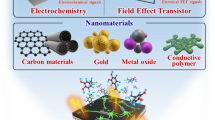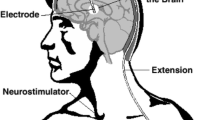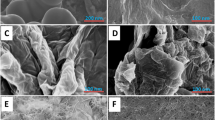Abstract
Dopamine belongs to the class of catecholamine neurotransmitters which have vital roles in the human central nervous system. Due to its importance in signal transmission in the nervous system, the abnormal release of dopamine is critical for the development of a number of neurological diseases/disorders, including Parkinson’s diseases, attention deficit hyperactivity disorder, and even drug addiction. Hence, there is an utmost need to develop platforms for the quantitative detection of dopamine in the human body in a rapid, sensitive, and label-free manner. A variety of nanomaterials have been explored and integrated into dopamine sensing platforms; in particular, electrochemical sensors can enhance both the sensitivity and selectivity toward dopamine, with promising results. The aim of this review is to summarize recent research on nanomaterial-modified dopamine electrochemical sensor platforms, particularly those that use nanoparticle-, graphene composite-, and transition metal dichalcogenide-modified electrodes. The information presented in this review might motivate the discovery or extension of nanomaterials with beneficial properties for the development of biosensors to detect various neurotransmitters including dopamine.





Similar content being viewed by others
References
Feigin, V.L. et al. Global, regional, and national burden of neurological disorders during 1990–2015: a systematic analysis for the Global Burden of Disease Study 2015. Lancet Neurol. 16, 877–897 (2017).
Choudhury, A. et al. Neurochemicals, behaviours and psychiatric perspectives of neurological diseases. Neuropsychiatry. 8, 395–424 (2018).
Mittal, R. et al. Neurotransmitters: The critical modulators regulating gut–brain axis. J. Cell. Physiol. 232, 2359–2372 (2017).
Paulose, C., K. Amee, and J. Anu. Neurotransmitters functional balance in neurodegenerative disease management: Recent Advances. Sci & Soc. 5(1), 23–30 (2006).
Gao, H.-M. and J.-S. Hong. Why neurodegenerative diseases are progressive: uncontrolled inflammation drives disease progression. Trends immunol. 29, 357–365 (2008).
Kumar, S., B.-S. Kim, and H. Song. An integrated approach of CNT front-end amplifier towards spikes monitoring for Neuro-prosthetic Diagnosis. BioChip J. 12, 332–339 (2018).
Wise, R.A. Dopamine, learning and motivation. Nat. Rev. Neurosci. 5, 483 (2004).
Kang, Y.J., E.G. Cutler, and H. Cho. Therapeutic nanoplatforms and delivery strategies for neurological disorders. Nano Converg. 5, 35 (2018).
Dobryakova, E. et al. The dopamine imbalance hypothesis of fatigue in multiple sclerosis and other neurological disorders. Front. neurol. 6, 52–52 (2015).
Kesby, J.P. et al. Dopamine, psychosis and schizophrenia: the widening gap between basic and clinical neuroscience. Transl. Psychiatry. 8, 30 (2018).
Segura–Aguilar, J. et al. Protective and toxic roles of dopamine in Parkinson's disease. J. Neurochem. 129, 898–915 (2014).
Zhang, X. et al. Highly sensitive and selective detection of dopamine using one-Pot synthesized highly photoluminescent silicon nanoparticles. Anal. Chem. 87, 3360–3365 (2015).
Huang, C. et al. Electrogenerated chemiluminescence behavior of peptide nanovesicle and its application in sensing dopamine. Biosens. Bioelectron. 63, 478–482 (2015).
De Benedetto, G.E. et al. A rapid and simple method for the determination of 3, 4-dihydroxyphenylacetic acid, norepinephrine, dopamine, and serotonin in mouse brain homogenate by HPLC with fluorimetric detection. J. Pharm. Biomed. Anal. 98, 266–270 (2014).
Su, H. et al. Colorimetric sensing of dopamine based on the aggregation of gold nanoparticles induced by copper ions. Anal. Methods. 4, 3981–3986 (2012).
Chen, Z., C. Zhang, and C. Wang. A colorimetric assay of dopamine utilizing melamine modified gold nanoparticle probes. Anal. Methods. 7, 838–841 (2015).
Kim, D.-S. et al. Electrochemical detection of dopamine using periodic cylindrical gold nanoelectrode arrays. Sci. Rep. 8, 14049 (2018).
Choo, S.-S. et al. Electrochemical detection of dopamine using 3D porous graphene oxide/gold nanoparticle composites. Sensors (Basel, Switzerland). 17, 861 (2017).
Si, B. and E. Song. Recent advances in the detection of neurotransmitters. Chemosensors. 6, 1 (2018).
Jackowska, K. and P. Krysinski. New trends in the electrochemical sensing of dopamine. Anal. Bioanal. Chem. 405, 3753–3771 (2013).
Bucher, E.S. and R.M. Wightman. Electrochemical analysis of neurotransmitters. Annu. Rev. Anal. Chem. (Palo Alto, Calif.). 8, 239–261 (2015).
Suhito, I. et al. Nanobiosensing platforms for realtime and non-invasive monitoring of stem cell pluripotency and differentiation. Sensors. 18, 2755 (2018).
Suhito, I.R. et al. Effects of two-dimensional materials on human mesenchymal stem cell behaviors. Biochem. Biophys. Res. Commun. 493, 578–584 (2017).
Hamzah, H.H. et al. 3D printable conductive materials for the fabrication of electrochemical sensors: A mini review. Electrochem. Commun. 96, 27–31 (2018).
Zhu, C. et al. Electrochemical sensors and biosensors based on nanomaterials and nanostructures. Anal. Chem. 87, 230–249 (2014).
Jiang, K. et al. Rapid and highly sensitive detection of dopamine using conjugated oxaborole-based Polymer and Glycopolymer Systems. ACS Appl. Mater. Interfaces. 9, 15225–15231 (2017).
Al-Graiti, W. et al. Probe sensor using nanostructured multi-walled carbon nanotube yarn for selective and sensitive detection of dopamine. Sensors (Basel, Switzerland). 17, 884 (2017).
Xu, G. et al. Sensitive, selective, disposable electrochemical dopamine sensor based on PEDOT-modified laser scribed graphene. Biosens. Bioelectron. 107, 184–191 (2018).
Zhou, W.-H. et al. Gold nanoparticles sensitized ZnO nanorods arrays for dopamine electrochemical sensing. J. Electrochem Soc. 165, G3001–G3007 (2018).
Ramirez, S. et al. Gold nanostructures on self-assembled monolayers activity for epinephrine, noradrenaline and dopamine. J. Electroanal. Chem. 799, 349–357 (2017).
Zhang, C. et al. Facile fabrication of a 3, 4, 9, 10-perylene tetracarboxylic acid functionalized graphene–multiwalled carbon nanotube–gold nanoparticle nanocomposite for highly sensitive and selective electrochemical detection of dopamine. Analyst. (2018).
Talemi, R.P., S.M. Mousavi, and H. Afruzi. Using gold nanostars modified pencil graphite electrode as a novel substrate for design a sensitive and selective Dopamine aptasensor. Mater. Sci. Eng. C. 73, 700–708 (2017).
Taheri, R.A., K. Eskandari, and M. Negahdary. An electrochemical dopamine aptasensor using the modified Au electrode with spindle-shaped gold nanostructure. Microchem. J. 143, 243–251 (2018).
Sáenz, H.S.C. et al. Electrochemical dopamine sensor using a nanoporous gold microelectrode: a proofof-concept study for the detection of dopamine release by scanning electrochemical microscopy. Microchim. Acta. 185, 367 (2018).
Yang, Z. et al. Synthesis of Au@ Pt nanoflowers supported on graphene oxide for enhanced electrochemical sensing of dopamine. J. Electroanal. Chem. 817, 48–54 (2018).
Zhang, K. et al. Au-Pt bimetallic nanoparticles decorated on sulfonated nitrogen sulfur co-doped graphene for simultaneous determination of dopamine and uric acid. Talanta. 178, 315–323 (2018).
Hou, Y. et al. Three-dimensional graphene oxide foams loaded with AuPd alloy: a sensitive electrochemical sensor for dopamine. Microchim. Acta. 185, 397 (2018).
Dasari, B.L. et al. Graphene and derivatives–Synthesis techniques, properties and their energy applications. Energy. 140, 766–778 (2017).
Bang, K. et al. Effect of ribbon width on electrical transport properties of graphene nanoribbons. Nano Converg. 5, 7 (2018).
Garg, R. et al. Deposition methods of graphene as electrode material for organic solar cells. Adv. Energy Mater. 7, 1601393 (2017).
Yang, J.M., K.R. Kim, and C.S. Kim. Biosensor for rapid and sensitive detection of influenza virus. Biotechnol. Bioprocess Eng. 23, 371–382 (2018).
Karuwan, C. et al. Screen-printed graphene-based electrochemical sensors for a microfluidic device. Anal. Methods. 9, 3689–3695 (2017).
Balaji, A. and J. Zhang. Electrochemical and optical biosensors for early-stage cancer diagnosis by using graphene and graphene oxide. Cancer nanotechnol. 8, 10–10 (2017).
Wu, S. et al. Graphene-based electrochemical sensors. Small. 9, 1160–1172 (2013).
Zhang, C. et al. Graphene-based electrochemical glucose sensors: fabrication and sensing properties. Electroanalysis. 30, 2504–2524 (2018).
Xuan, X., H.S. Yoon, and J.Y. Park. A wearable electrochemical glucose sensor based on simple and low-cost fabrication supported micro-patterned reduced graphene oxide nanocomposite electrode on flexible substrate. Biosens. Bioelectron. 109, 75–82 (2018).
Zhang, H.-P. et al. Understanding the interfacial interactions between dopamine and different graphenes for biomedical materials. Mater. Chem. Front. 1, 1156–1164 (2017).
Raj, M. et al. Graphene/conducting polymer nanocomposite loaded screen printed carbon sensor for simultaneous determination of dopamine and 5-hydroxytryptamine. Sens. Actuators B: Chem. 239, 993–1002 (2017).
Oh, J. et al. Ultrasensitive and selective organic FETtype nonenzymatic dopamine sensor based on platinum nanoparticles-decorated reduced graphene oxide. ACS Appl. Mater. Interfaces. 9, 39526–39533 (2017).
He, Q. et al. Preparation of Cu2O-reduced graphene nanocomposite modified electrodes towards ultrasensitive dopamine detection. Sensors. 18, 199 (2018).
Xu, B. et al. Thiol-functionalized single-layered MoS2 nanosheet as a photoluminescence sensing platform via charge transfer for dopamine detection. Sens. Actuators B: Chem. 246, 380–388 (2017).
Kim, M.-J. et al. 2H-WS2Quantum dots produced by modulating the dimension and phase of 1Tnanosheets for antibody-free optical sensing of neurotransmitters. ACS Appl. Mater. Interfaces. 9, 12316–12323 (2017).
Han, J.H. et al. Recent advances in the solutionbased preparation of two-dimensional layered transition metal chalcogenide nanostructures. Chem. Rev. 118, 6151–6188 (2018).
Thanh, T.D. et al. Recent advances in two-dimensional transition metal dichalcogenides-graphene heterostructured materials for electrochemical applications. Prog. Mater. Sci. 96, 51–85 (2018).
Ping, J. et al. Recent advances in sensing applications of two–dimensional transition metal dichalcogenide nanosheets and their composites. Adv. Funct. Mater. 27, 1605817 (2017).
Zou, H.L. et al. 0D-2D heterostructures of Au nanoparticles and layered MoS2 for simultaneous detections of dopamine, ascorbic acid, uric acid, and nitrite. Sens. Actuators B: Chem. 253, 352–360 (2017).
Ma, G. et al. Growth of worm-like and flower-like molybdenum disulfide on graphene nanosheets for sensitive determination of dopamine. Int. J. Electrochem. Sci. 12, 7365–7376 (2017).
Sakthivel, R. et al. A novel flakes-like structure of molybdenum disulphide modified glassy carbon electrode for the efficient electrochemical detection of dopamine. Int. J. Electrochem. Sci. 12, 9288–9300 (2017).
Hun, X. et al. A photoelectrochemical sensor for ultrasensitive dopamine detection based on singlelayer NanoMoS2 modified gold electrode. Sens. Actuators B: Chem. 249, 83–89 (2017).
Vijayaraj, K. et al. One-step construction of a molybdenum disulfide/multi-walled carbon nanotubes/ polypyrrole nanocomposite biosensor for the exvivo detection of dopamine in mouse brain tissue. Biochem. Biophys. Res. Commun. 494, 181–187 (2017).
Mani, V., T.-W. Chen, and S. Selvaraj. MWCNTs/ MoS2 decorated cobalt oxide polyhedrons composite film modified electrode for electrochemical determination of dopamine in rat brain and human blood serum samples. Int. J. Electrochem. Sci. 12, 7435–7445 (2017).
Yue, H.Y. et al. Electrochemical determination of dopamine in the presence of uric acid using WS2 nanospheres-carbon nanofibers. J. Electroanal. Chem. 833, 427–432 (2019).
Acknowledgments
This study was funded by the National Research Foundation of Korea (NRF) [Grant No. 2016R1C1B1016088], by the Mid-career Researcher Program [Grant No. 2016R1A2B4014541], and by the Nano Material Technology Development Program (funded by the Korean Government (MSIP) [NRF-2014 M3A7B4051907].
Author information
Authors and Affiliations
Corresponding author
Additional information
These authors contributed equally to this work.
Appendices
Conflict of Interests
The authors declare no competing financial interests.
Author’s contributions
I.R.S, N.A and T,-H.K. searched references & collected information. I.R.S. and N.A. produce table, figures, and figure captions. T,- H.K. established the structure of manuscript. All authors wrote and reviewed the manuscript.
Rights and permissions
About this article
Cite this article
Suhito, I.R., Angeline, N. & Kim, TH. Nanomaterial-modified Hybrid Platforms for Precise Electrochemical Detection of Dopamine. BioChip J 13, 20–29 (2019). https://doi.org/10.1007/s13206-019-3106-x
Received:
Accepted:
Published:
Issue Date:
DOI: https://doi.org/10.1007/s13206-019-3106-x




